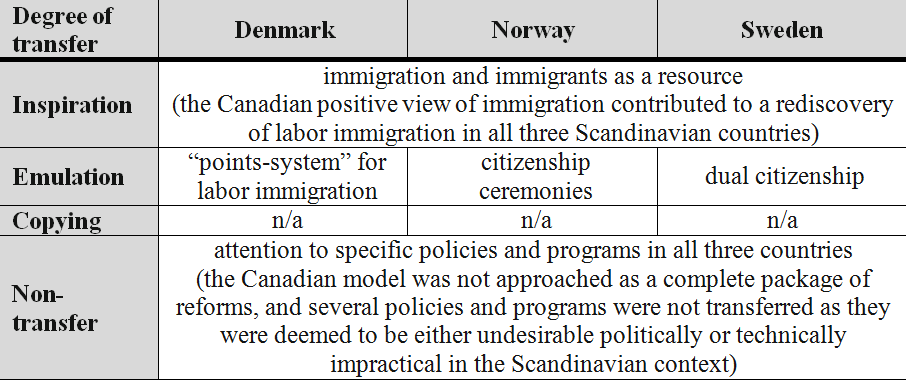 Dr. Trygve Ugland, professor at Bishop’s University in Quebec, recently published a paper titled “Canada as an Inspirational Model: Reforming Scandinavian Immigration and Integration Policies,” in the Nordic Journal of Migration Research. New Canadian Media interviewed him on his study: the first systematic study of the international relevance of the Canadian immigration system. (Please also read relevant abstracts provided below in support of his responses to our questions).
Dr. Trygve Ugland, professor at Bishop’s University in Quebec, recently published a paper titled “Canada as an Inspirational Model: Reforming Scandinavian Immigration and Integration Policies,” in the Nordic Journal of Migration Research. New Canadian Media interviewed him on his study: the first systematic study of the international relevance of the Canadian immigration system. (Please also read relevant abstracts provided below in support of his responses to our questions).
Dr. Ugland describes himself as a “European living in North America.” He was educated in Oslo and Belfast, obtaining his Ph.D. from the University of Oslo in 2002.
1. How did you arrive at this topic for your research?
I have been interested in issues related to the field of comparative public policy since I was a student. In particular, I am fascinated by the processes of learning across borders. The challenge posed by increasing immigration and ethno-cultural diversity is a major concern for governments across the world, and different immigration and integration policy solutions exist internationally. It is interesting to study to what extent apparently successful national models and solutions are used elsewhere.
2. You found in your study that Canada has managed to reconcile important welfare state objectives with increased immigration and diversity? Could you please explain?
The notion that there is a potential trade-off between a more open and accommodating approach to immigration and the maintenance of a robust welfare state has been increasingly expressed in many European countries.
However, Canada has managed to reconcile important welfare state objectives and principles with increased immigration and diversity. Although not as comprehensive and generous as the Scandinavian welfare states, the Canadian social security system includes unemployment insurance, child tax credits, universal childcare benefits, medicare, the Canada Pension Plan, old age security, and social assistance. In contrast to many other countries, Canada has not actively sought to fence off the welfare state from newcomers. Further, public attitudes in Canada reveal little tension between ethnic diversity and support for social programs. In fact, the welfare state and multiculturalism are for many Canadians the two most important ingredients in the Canadian identity, i.e. what it means to be Canadian.
Although there is little evidence to support the contention that increasing ethnic diversity as such has adverse effects on established welfare states (Banting & Kymlicka 2006), a growing chorus of commentators has argued that ethnic/racial diversity makes it more difficult to sustain redistributive policies.
In fact, Canada has been described as a “statistical outlier” in that it has managed to combine high levels of diversity with peace, democracy, economic prosperity, and individual freedom (Laczko 1994; Kymlicka 2007a). Further, Canada has also managed to reconcile important welfare state objectives and principles with increased immigration, and public attitudes reveal little tension between ethnic diversity and support for social programs (Banting 2010).
The universalistic and generous Scandinavian welfare model has been regarded as particularly vulnerable: “immigration to a country that espouses the principle of equal treatment and has an extensive welfare state challenges the population’s generosity in the first instance, and may in the longer term affect the sustainability of the system itself if the bulk of the newcomers are unable to support themselves” (Brochmann 2003: 6).
3. What were the main findings in your paper entitled “Canada as an Inspirational Model: Reforming Scandinavian Immigration and Integration Policies”?
My article deals with the international relevance and reputation of the Canadian immigration and integration policy model. A key finding here is that Canada served as an important inspirational model for the Scandinavian countries during the 2000-2012 period. In particular, Canada has a strong reputation in Scandinavia as a country that views immigration and immigrants as a resource. In this respect, the transnational inspiration from Canada contributed significantly to the rediscovery of labour immigration in Denmark, Norway and Sweden during the 2000s.
The Scandinavian countries have often been portrayed as models for the development of policies for other states. However, in the area of immigration and integration policies, Denmark, Norway and Sweden have themselves been searching for inspiration and for new policy solutions abroad. Canada is internationally recognized in the areas of immigration control and immigrant integration, and this article focuses on the role the Canadian immigration and integration policy model has played in the Scandinavian reform process in the period from 2000 to 2012. The overall conclusion is that the Canadian model has significantly shaped the reform debate and process in the three Scandinavian countries. However, the Canadian model has not been copied or emulated to a great extent. Instead, it has served as intellectual stimulus and a model for inspiration. In particular, the Canadian model served as inspiration for the rediscovery of labor immigration in Scandinavia during the 2000s.
4. Were you surprised at the level of interest from Scandinavian countries in Canada’s immigration policy?
I was not surprised by the level of interest because the Canadian model is widely recognized as a successful international solution when it comes to dealing with the immigration and integration issues. However, the degree of systematic attention devoted to the Canadian model from the Scandinavian countries was more prominent than expected. Information about the Canadian model was systematically collected through everything from expert analyses of policy documents to organized study trips to Canada by Scandinavian actors. For instance, approximately 100 Swedish MPs visited Canada over a 3 year period to learn more about Canadian policies and practices related to immigration control and immigrant integration. Officials at Citizenship and Immigration Canada (CIC) interviewed for the study confirmed this overwhelming interest from Sweden, in particular.
5. Given your own Scandinavian heritage, how do you explain this interest? Are there cultural/other factors that make Canada a good model for Denmark, Sweden and Norway?
The Scandinavian countries share a common history of migration, and they can all be described as latecomers in terms of immigration. While Sweden began receiving significant numbers of immigrants during the 1950s, Denmark and Norway did not become net receivers of migrants until the late 1960s. Canadian experiences as a traditional immigration country are of interest for non-traditional immigration countries like Denmark, Norway and Sweden. The idea here is that there may be something to learn from countries that have dealt with these issues for a longer period of time
Further, Canada’s combination of an open and accommodating approach to immigration and increasing ethnic diversity with a comprehensive welfare state system is something that is very interesting for the Scandinavians, which are world renown for their generous welfare state systems.
6. Do you think Canada’s government actively positions itself as a role model for immigration policy?
It is clear that Canada has actively promoted its immigration and integration policy abroad. One of the main goals of Canada’s foreign policy is to promote a greater understanding and appreciation internationally of Canada and “Canadian values”. According to the Canadian government, one of three central objectives of the Multiculturalism Program is to: “Actively engage in discussions on multiculturalism at the international level”. The Canadian government has done this by funding academic research, conferences, and policy workshops that explore the international relevance of Canadian policies and practices.
This illustrates that the Canadian model that has been seen as a product of unique and favorable domestic circumstances can still be relevant in countries lacking these underlying conditions. Moreover, the article demonstrates a change in roles, where Canada – often described as a policy borrower – acted as an inspirational model for the Scandinavian countries, which commonly are classified as policy lenders.
7. Have you also looked at international models that influence Canada’s immigration/citizenship policies? What are they?
As information about policy in other countries has become more readily available, learning from abroad has attracted increasing interests among academics, policy practitioners and politicians. In the policy literature, some countries have generally been regarded as borrowers of policies from other countries, while others have been classified as lenders. While the latter categorization often has been assigned to the Scandinavian countries, Canada has generally been described as a borrower. This article illustrates how a traditional policy borrower (Canada) acted as an inspirational model for countries often classified as policy lenders (the Scandinavian countries). In fact, Canada is both presenting itself and being perceived as an international model in the areas of immigration control and immigrant integration.
8. Do you need to revisit your findings in light of changes in Canada’s immigration policy since 2012 (your study covered 2000-2012)?
Immigration and integration policy issues are still high on the political agenda in Denmark, Norway and Sweden, and the three Scandinavian countries continue to look abroad for inspiration. However, the Canadian immigration and integration policy model is not static nor is its international reputation. The Conservative government that came into power in 2006 has adopted several changes in both policies and practices. Although my study found that the Canadian model still serves as an inspirational model in Scandinavia, future research should pay close attention to how changes and shifts in domestic policy priorities impact its international reputation in Scandinavia and elsewhere. This is exactly what I intend to do.
Read the whole study here (hyperlinked).





